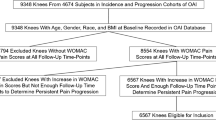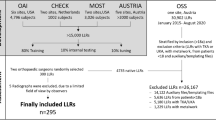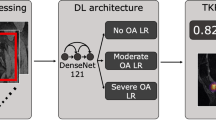Abstract
Purpose
To (1) develop a deep-learning (DL) algorithm capable of producing limb-length and knee-alignment measurements, and (2) determine the association between limb-length discrepancy (LLD), coronal-plane alignment, osteoarthritis (OA) severity, and patient-reported knee pain.
Methods
A multicenter, prospective patient cohort from the Osteoarthritis Initiative between 2004 and 2015 with full-limb standing radiographs at 12 month follow-up was included. A convolutional neural network was developed to automate measurements of the hip–knee–ankle (HKA) angle, femur, and tibia lengths, and LLD. At 12 month follow-up, patients reported their frequency of knee pain since enrollment and current level of knee pain.
Results
A total of 1011 patients (2022 knees, 52.3% female) with an average age of 61.2 ± 9.0 years were included. The algorithm performed 12,312 measurements in 5.4 h. ICC values of HKA and LLD ranged between 0.87 and 1.00 when compared against trained radiologist measurements. Knees producing pain most days of the month were significantly more varus (mean HKA:− 3.9° ± 2.8°) or valgus (mean HKA:2.8° ± 2.3°) compared to knees that did not produce any pain (p < 0.05). In varus knees, those producing pain on most days were part of the shorter limb compared to nonpainful knees (p < 0.05). Baseline Kellgren–Lawrence grade was significantly associated with HKA magnitude, LLD, and pain frequency at 12 month follow-up (p < 0.05 all).
Conclusion
A higher frequency of knee pain was associated with more severe coronal plane deformity, with valgus deviation being one degree less than varus on average, suggesting that the knee tolerates less valgus deformation before symptoms become more consistent. Knee pain frequency was also associated with greater LLD and baseline KL grade, suggesting an association between radiographically apparent joint degeneration and pain frequency.
Level of evidence
IV case series.







Similar content being viewed by others
References
Bernstein M, Fragomen AT, Sabharwal S, Barclay J, Rozbruch SR (2015) Does integrated fixation provide benefit in the reconstruction of posttraumatic tibial bone defects? Clin Orthop Relat Res 473:3143–3153
Burns JE, Yao J, Summers RM (2020) Artificial intelligence in musculoskeletal imaging: a paradigm shift. J Bone Miner Res 35:28–35
Cerejo R, Dunlop DD, Cahue S, Channin D, Song J, Sharma L (2002) The influence of alignment on risk of knee osteoarthritis progression according to baseline stage of disease. Arthritis Rheum 46:2632–2636
Gavaskar AS, Srinivasan P, Raj RV, Jayakumar B, Pattabiraman K (2021) What is the likelihood of union after coronal limb realignment using revision osteosynthesis and concurrent TKA in patients with advanced arthritis and loss of fixation after distal metaphyseal femur fractures? Clin Orthop Relat Res 479:1252–1261
Gulshan V, Peng L, Coram M, Stumpe MC, Wu D, Narayanaswamy A et al (2016) Development and validation of a deep learning algorithm for detection of diabetic retinopathy in retinal fundus photographs. JAMA 316:2402–2410
Hamdy RC, Bernstein M, Fragomen AT, Rozbruch SR (2016) What’s new in limb lengthening and deformity correction. J Bone Joint Surg Am 98:1408–1415
Hevesi M, Wyles CC, Rouzrokh P, Erickson BJ, Maradit-Kremers H, Lewallen DG et al (2022) Redefining the 3D topography of the acetabular safe zone: a multivariable study evaluating prosthetic hip stability. J Bone Joint Surg Am 104:239–245
Hosny A, Parmar C, Quackenbush J, Schwartz LH, Aerts H (2018) Artificial intelligence in radiology. Nat Rev Cancer 18:500–510
Jang SJ, Kunze KN, Vigdorchik JM, Jerabek SA, Mayman DJ, Sculco PK (2022) John charnley award: deep learning prediction of hip joint center on standard pelvis radiographs. J Arthroplast. https://doi.org/10.1016/j.arth.2022.03.033
Li Z, Esposito CI, Koch CN, Lee YY, Padgett DE, Wright TM (2017) Polyethylene damage increases with varus implant alignment in posterior-stabilized and constrained condylar knee arthroplasty. Clin Orthop Relat Res 475:2981–2991
MacDessi SJ, Griffiths-Jones W, Harris IA, Bellemans J, Chen DB (2021) Coronal plane alignment of the knee (CPAK) classification. Bone Joint J 103-B(2):329–337
Matassi F, Cozzi Lepri A, Innocenti M, Zanna L, Civinini R, Innocenti M (2019) Total knee arthroplasty in patients with extra-articular deformity: restoration of mechanical alignment using accelerometer-based navigation system. J Arthroplast 34:676–681
McCoy TH Jr, Kim HJ, Cross MB, Fragomen AT, Healey JH, Athanasian EA et al (2013) Bone tumor reconstruction with the Ilizarov method. J Surg Oncol 107:343–352
Pierson E, Cutler DM, Leskovec J, Mullainathan S, Obermeyer Z (2021) An algorithmic approach to reducing unexplained pain disparities in underserved populations. Nat Med 27:136–140
Ramkumar PN, Kunze KN, Haeberle HS, Karnuta JM, Luu BC, Nwachukwu BU et al (2021) Clinical and research medical applications of artificial intelligence. Arthroscopy 37:1694–1697
Ritter MA, Davis KE, Meding JB, Pierson JL, Berend ME, Malinzak RA (2011) The effect of alignment and BMI on failure of total knee replacement. J Bone Joint Surg Am 93:1588–1596
Ronneberger O, Fischer P, Brox T (2015) U-net: convolutional networks for biomedical image segmentation. Sprimger, Cham
Rouzrokh P, Wyles CC, Philbrick KA, Ramazanian T, Weston AD, Cai JC et al (2021) A deep learning tool for automated radiographic measurement of acetabular component inclination and version after total hip arthroplasty. J Arthroplast 36(2510–2517):e2516
Rozbruch SR, Birch JG, Dahl MT, Herzenberg JE (2014) Motorized intramedullary nail for management of limb-length discrepancy and deformity. J Am Acad Orthop Surg 22:403–409
Schock J, Truhn D, Abrar DB, Merhof D, Conrad S, Post M et al (2021) Automated analysis of alignment in long-leg radiographs by using a fully automated support system based on artificial intelligence. Radiol Artif Intell 3:e200198
Schwartz JT, Cho BH, Tang P, Schefflein J, Arvind V, Kim JS et al (2021) Deep learning automates measurement of spinopelvic parameters on lateral lumbar radiographs. Spine 46:E671–E678
Seabold S, Perktold J (2010) Statsmodels: econometric and statistical modeling with python. paper presented at: proceedings of the 9th python in science conference (SCIPY 2010) June 28–July 3 Austin, TX, USA
Sekiguchi K, Nakamura S, Kuriyama S, Nishitani K, Ito H, Tanaka Y et al (2019) Effect of tibial component alignment on knee kinematics and ligament tension in medial unicompartmental knee arthroplasty. Bone Joint Res 8:126–135
Sharma L, Song J, Felson DT, Cahue S, Shamiyeh E, Dunlop DD (2001) The role of knee alignment in disease progression and functional decline in knee osteoarthritis. JAMA 286:188–195
Westberry DE, Carpenter AM, Prodoehl J (2020) Correction of genu valgum in patients with congenital fibular deficiency. J Pediatr Orthop 40:367–372
Yeh YC, Weng CH, Huang YJ, Fu CJ, Tsai TT, Yeh CY (2021) Deep learning approach for automatic landmark detection and alignment analysis in whole-spine lateral radiographs. Sci Rep 11:7618
Yu KH, Beam AL, Kohane IS (2018) Artificial intelligence in healthcare. Nat Biomed Eng 2:719–731
Zheng Q, Shellikeri S, Huang H, Hwang M, Sze RW (2020) Deep learning measurement of leg length discrepancy in children based on radiographs. Radiology 296:152–158
Zou KH, Warfield SK, Bharatha A, Tempany CM, Kaus MR, Haker SJ et al (2004) Statistical validation of image segmentation quality based on a spatial overlap index. Acad Radiol 11:178–189
Funding
No funding was received for this work.
Author information
Authors and Affiliations
Contributions
KK: writing of initial manuscript, methodology, and supervision. SJ: writing of initial manuscript and data analysis. TL: data procurement and data analysis. DM, JV, PS, AF, and SJ: revision of initial manuscript and supervision.
Corresponding author
Ethics declarations
Conflict of interest
Each author certifies that he or she has no commercial associations (e.g., consultancies, stock ownership, equity interest, patent/licensing arrangements, etc.) that might pose a conflict of interest in connection with the submitted article.
Ethical approval
This study was conducted using a public de-identified online database (Osteoarthritis Initiative) for secondary data analysis. The creation of the database was approved by the institutional review board at the respective institutions involved in the OAI.
Additional information
Publisher's Note
Springer Nature remains neutral with regard to jurisdictional claims in published maps and institutional affiliations.
Supplementary Information
Below is the link to the electronic supplementary material.

167_2022_7213_MOESM1_ESM.jpg
Supplementary file1 Correlation plot between deep learning derived and radiologist derived measurements in all knees (JPG 661 KB)

167_2022_7213_MOESM2_ESM.jpg
Supplementary file2 Association between baseline KL grade and coronal plane alignment at one-year stratified by grade (JPG 660 KB)


Rights and permissions
Springer Nature or its licensor (e.g. a society or other partner) holds exclusive rights to this article under a publishing agreement with the author(s) or other rightsholder(s); author self-archiving of the accepted manuscript version of this article is solely governed by the terms of such publishing agreement and applicable law.
About this article
Cite this article
Kunze, K.N., Jang, S.J., Li, T. et al. Radiographic findings involved in knee osteoarthritis progression are associated with pain symptom frequency and baseline disease severity: a population-level analysis using deep learning. Knee Surg Sports Traumatol Arthrosc 31, 586–595 (2023). https://doi.org/10.1007/s00167-022-07213-x
Received:
Accepted:
Published:
Issue Date:
DOI: https://doi.org/10.1007/s00167-022-07213-x




